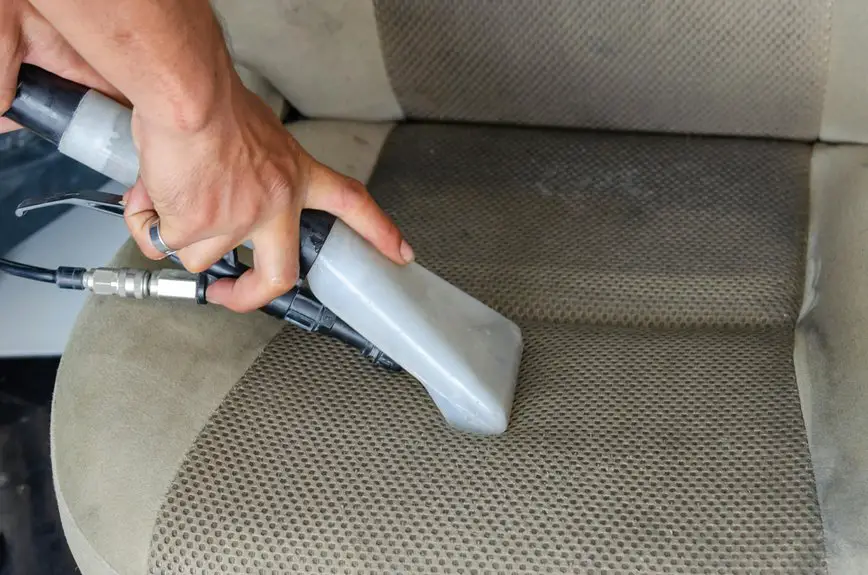To remove coffee stains from your upholstery, first identify the fabric type to choose the right cleaning method. Blot the stain gently with a clean cloth; avoid rubbing. Use a mixture of cold water and liquid dish soap or white vinegar for fresh stains. For older stains, try commercial cleaners or enzyme solutions. Always air dry the area afterward. Taking quick action and following proper techniques can save your furniture—keep going to discover more effective tips and tricks.
Table of Contents
Key Takeaways
- Blot the coffee spill immediately with a clean cloth, avoiding rubbing to prevent stain spreading.
- Mix one tablespoon of liquid dish soap with two cups of cold water and gently dab the stain.
- For tougher stains, apply equal parts white vinegar and water, let sit, then blot and rinse with cold water.
- Use commercial upholstery cleaners for old or set-in stains, testing first on a hidden area to avoid discoloration.
- After treatment, pat the area dry with a clean towel and allow upholstery to air dry completely away from heat.
Identifying Different Types of Upholstery Fabrics
How can you tell what type of fabric covers your upholstery? Start by checking any tags or labels; manufacturers often list fabric content there.
If no label is available, feel the texture—cotton feels soft and breathable, while polyester is smoother and less absorbent. Leather has a distinct, firm feel with natural grain patterns.
You can also perform a simple burn test on a hidden fabric scrap: natural fibers like cotton smell like burning paper, while synthetics smell chemical.
Knowing your fabric type is essential because each reacts differently to cleaning methods and stain removers. Identifying whether your upholstery is natural, synthetic, or a blend helps you choose the safest and most effective way to tackle coffee stains without causing damage.
Immediate Steps to Take After a Coffee Spill
When coffee spills on your upholstery, act fast to prevent a stubborn stain.
Blot the area gently with a clean cloth—never rub—and use cold water to help lift the spill.
Quick action makes all the difference in keeping your fabric looking fresh.
Blot, Don’t Rub
Act quickly to blot the coffee spill with a clean cloth or paper towel—you don’t want to rub it in. Rubbing spreads the stain deeper into the fabric and makes it harder to remove.
Instead, gently press the cloth onto the spill to absorb as much liquid as possible. Keep switching to a dry area of the cloth to avoid reapplying the stain. This simple step can save your upholstery from lasting damage.
Remember:
- You only have seconds before the stain sets.
- Blotting protects your favorite sofa.
- Rubbing can ruin your fabric’s texture.
- Patience here means easier cleaning later.
- Acting fast restores your peace of mind.
Stay calm and blot carefully—the stain doesn’t stand a chance.
Use Cold Water
After blotting up as much coffee as possible, reach for cold water to tackle the stain further.
Cold water helps prevent the coffee from setting into the fabric fibers, making it easier to remove. Dampen a clean cloth or sponge with cold water and gently blot the stained area.
Avoid soaking the upholstery, as too much moisture can damage the fabric or padding beneath. Continue blotting with cold water, switching to a fresh cloth as it absorbs the coffee.
This process dilutes the stain and lifts coffee particles from the upholstery. Remember, using cold water is essential—hot water can cause the stain to set permanently.
Once you’ve treated the stain with cold water, prepare for the next steps to clean thoroughly and restore your upholstery.
Act Quickly
Since coffee stains can set quickly, you need to respond immediately to prevent permanent damage.
Don’t let panic slow you down—grab a clean cloth or paper towel and gently blot the spill. Avoid rubbing, which can push the stain deeper into the fabric. Act fast to stop the stain from spreading and soaking in.
Here’s what you should do right after the spill:
- Blot excess coffee gently without rubbing
- Use cold water to dampen the stained area
- Avoid applying heat or harsh chemicals
- Keep pets and kids away from the stain zone
- Prepare your cleaning supplies so you’re ready
Taking these quick steps saves your upholstery and eases your mind. You’ve got this!
Using Household Ingredients to Treat Coffee Stains
You can tackle coffee stains on upholstery effectively using common household ingredients you probably already have.
Start by blotting the stain gently with a clean cloth to absorb excess liquid. Mix one tablespoon of liquid dish soap with two cups of cold water. Using a clean cloth, apply this solution to the stain, gently dabbing rather than rubbing.
Blot the stain gently, then dab with dish soap mixed in cold water—avoid rubbing to protect fabric.
For tougher stains, combine equal parts white vinegar and water, then dab the mixture onto the stained area. After applying any solution, blot with a dry cloth to lift the stain and moisture.
Finally, rinse by dabbing with plain cold water and blot dry. These simple household ingredients can restore your upholstery without harsh chemicals, saving time and money while protecting your fabric.
Commercial Upholstery Cleaners and When to Use Them
While household ingredients work well for many coffee stains, some situations call for a stronger solution. Commercial upholstery cleaners are specially formulated to tackle stubborn stains without damaging your fabric.
You should consider using them when:
- The stain is old and has set deep into the fibers
- You’ve tried home remedies without success
- The upholstery is delicate and needs gentle, effective treatment
- You want a quick and reliable stain removal option
- You’re dealing with large or multiple coffee spills
Before applying, always test the cleaner on a hidden area to verify it won’t discolor or harm your upholstery.
Using the right commercial cleaner can save your furniture and restore its look quickly, giving you peace of mind when tackling tough coffee stains.
Techniques for Removing Old and Set-In Coffee Stains
When you’re tackling old coffee stains, pre-treating the area is key to loosening stubborn residue.
You’ll want to use enzyme cleaners that break down the stain proteins without damaging your upholstery.
Combine this with gentle scrubbing techniques to lift the stain effectively without harming the fabric.
Pre-treating Old Stains
Although old coffee stains can be stubborn, you can still lift them effectively with the right pre-treatment. Start by gently blotting the stain to remove any surface residue without rubbing it deeper.
Next, apply a mixture of equal parts white vinegar and water to break down the stain’s molecules. Let it sit for 10-15 minutes, then blot again.
For tougher stains, sprinkle baking soda, which acts as a natural abrasive and deodorizer, then spray with the vinegar solution to create a fizzing action that lifts dirt.
Finally, rinse with cold water and blot dry.
- Feel relief as the stubborn stain begins to fade.
- Enjoy the fresh scent replacing stale odors.
- Reclaim your upholstery’s original beauty.
- Gain confidence in handling future spills.
- Avoid costly professional cleaning bills.
Using Enzyme Cleaners
Since old and set-in coffee stains can resist traditional cleaning methods, using enzyme cleaners offers a powerful solution. These cleaners break down protein-based stains like coffee, making removal easier. To use, apply the enzyme cleaner directly to the stain, let it sit for 10-15 minutes, then blot with a clean cloth. Avoid rinsing immediately to allow enzymes to work effectively.
| Step | Action |
|---|---|
| Apply | Spray enzyme cleaner on stain |
| Wait | Let it sit for 10-15 minutes |
| Blot | Use a clean cloth to absorb |
| Repeat if needed | Reapply for stubborn stains |
This method is safe for most upholstery fabrics but always test on a hidden spot first. Enzyme cleaners can revive even the toughest, set-in coffee stains.
Gentle Scrubbing Techniques
A careful touch goes a long way in tackling old coffee stains on upholstery. When scrubbing, you want to be firm but gentle to avoid damaging the fabric.
Start by dampening the stained area with a mild cleaning solution or water. Use a soft-bristled brush or a clean cloth to lightly scrub the stain in small, circular motions. Avoid harsh scrubbing, which can spread the stain or wear down fibers.
Remember to:
- Test any cleaner on a hidden spot first
- Work from the stain’s edges toward the center
- Keep the fabric moist, not soaked
- Rinse your brush or cloth frequently
- Pat dry with a clean towel after scrubbing
This approach helps lift set-in stains without harming your upholstery’s texture.
Preventative Measures to Protect Upholstery From Future Stains
To keep your upholstery looking fresh, you should take proactive steps that minimize the risk of coffee stains before they happen.
Start by applying a fabric protector spray designed to repel liquids and prevent stains from setting. Always use coasters or trays when placing coffee cups on upholstered furniture to catch spills. Establish a no-drinking zone on delicate or light-colored pieces to reduce accidents.
Apply fabric protector sprays, use coasters, and set no-drinking zones to prevent coffee stains on upholstery.
Regularly vacuum your upholstery to remove dust and dirt that can trap stains. Quickly blot any spills with a clean cloth instead of rubbing, which can push stains deeper.
Finally, consider using washable slipcovers or throw blankets that you can easily clean. These simple measures will help you maintain your upholstery’s appearance and save you time on tough stain removals later.
Frequently Asked Questions
Can Coffee Stains Cause Permanent Fabric Damage?
Yes, coffee stains can cause permanent fabric damage if you don’t act quickly. The longer the stain sits, the harder it is to remove, and it might leave a lasting discoloration on your upholstery.
Are Coffee Stains Harmful to Pets or Children?
Like a tiny villain in a story, coffee stains aren’t toxic, but you shouldn’t let your pets or kids lick them. They can cause mild upset or irritation, so it’s best you clean spills quickly.
How Long Should Upholstery Dry After Cleaning?
You should let your upholstery dry for at least 4 to 6 hours after cleaning. Make sure the area is well-ventilated and avoid using the furniture during this time to prevent new stains or damage.
Can Professional Cleaning Services Guarantee Stain Removal?
Just like a magician can’t promise every trick, professional cleaning services can’t guarantee complete stain removal due to fabric type and stain age. But they’ll use their best skills to make your upholstery look nearly spotless.
Does Hot Coffee Cause Worse Stains Than Cold Coffee?
Yes, hot coffee usually causes worse stains than cold coffee because the heat helps the pigments penetrate fabric fibers deeper. You’ll find hot stains harder to remove, so act quickly to prevent permanent damage.
- Woven vs. Nonwoven Bandages: A Medical Perspective - July 12, 2025
- How to Identify High-Quality Nonwoven Interfacing - July 12, 2025
- The Use of Nonwovens in Construction and Civil Engineering - July 12, 2025







